A delicious vegan brioche made with extra virgin olive oil instead of butter. This dairy-free, eggless version of the classic French bread bakes up stunningly golden brown and fluffy with a soft, light and tender crumb. I've included a video that goes through the entire process step by step so you can easily make this gorgeous brioche.
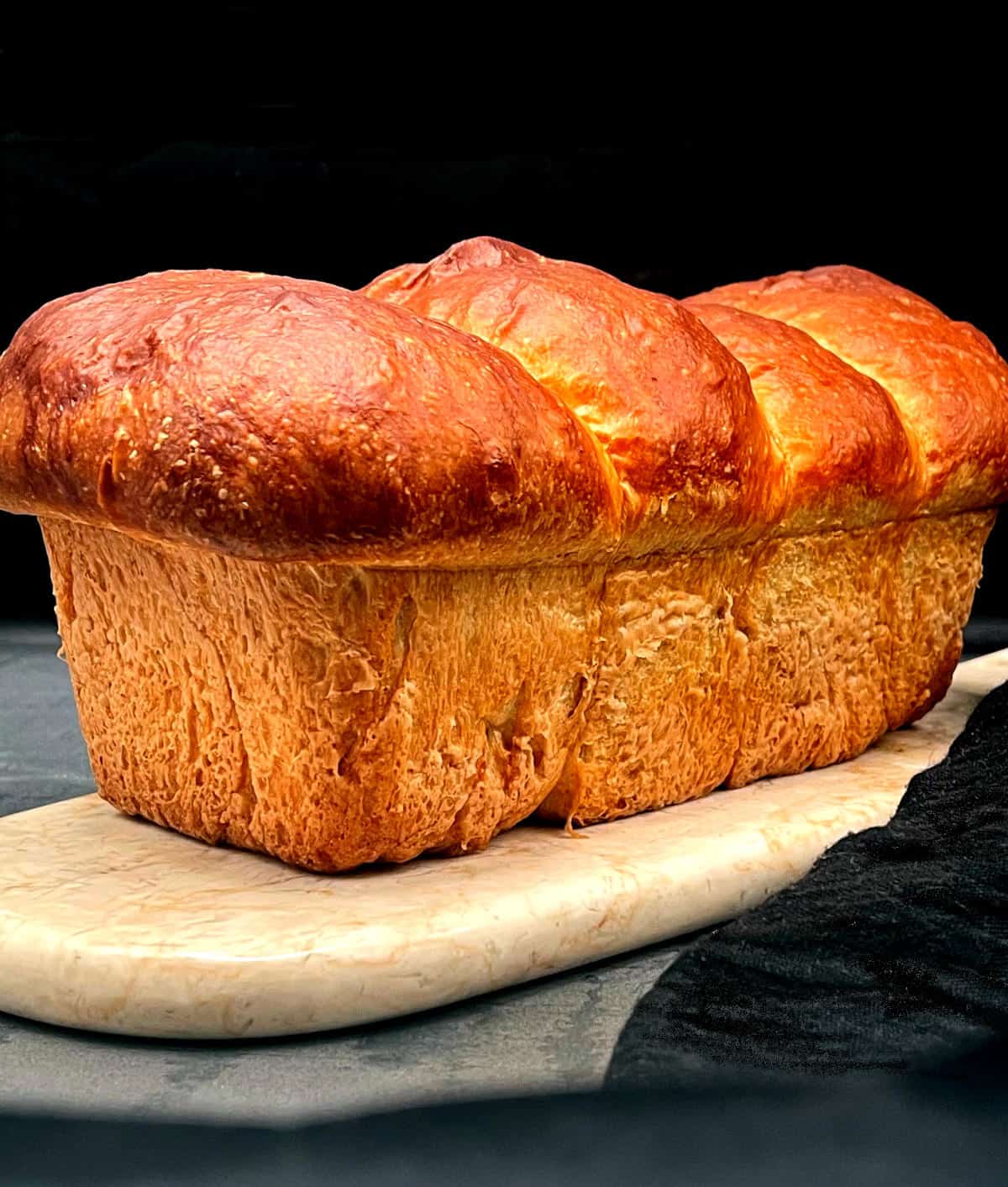
There is something rather addictive about a brioche: a goodness so subtle, it makes me wonder if the femme or homme who uttered the phrase "je ne sais quoi" for the first time ever was tucking into a brioche.
This beautiful bread has a light but close-knit and soft crumb, an elegant, barely-there sweetness, and a flaky, golden crust that melts in your mouth. In France, a brioche (pronounced bri-yosh) is considered a "viennoiserie," a breakfast bread like croissant, falling as it does at the cusp of a bread and a cake.
Traditional brioche recipes uses a ton of butter and eggs to get that incredible texture and rich flavor. But making a perfect brioche without eggs and butter is very possible. I've shared with you two versions of a vegan brioche in past years: a stunning avocado brioche, that uses avocado in lieu of most of the butter, and this recipe that I am resharing today with updated photos and a video that shows the entire process step by step: a vegan olive oil brioche.
This vegan brioche uses aquafaba or chickpea brine instead of eggs (a technique I also use in my vegan chocolate babka). It is a must-try if you love baking bread. The aquafaba gives the bread a wonderful lightness and helps achieve that perfect, soft, feathery texture. Olive oil stands in nicely for the butter, and it makes this indulgent bread a little healthier too!
Table of Contents
Why you will love this vegan brioche
- Perfect texture. Vegan brioche recipes often sacrifice the eggs and just use vegan butter instead of regular butter. But the eggs are a key ingredient in this bread and without them you won't get that light texture so important in a brioche. Aquafaba solves that problem with ease, allowing for that amazing texture without the eggs.
- Rich flavor. The extra virgin olive oil adds the perfect, rich flavor to the brioche, and it keeps the bread healthier than if you were using vegan butter (store-bought versions tend to be ultra-processed).
- Easy recipe. It can be daunting to make a brioche, but rest easy because the step-by-step video demystifies the process so you can see exactly what the dough should look like at every stage of the process.
- Soy-free, nut-free and vegan recipe. It's hard to imagine anyone could keep their hands off this amazing bread, and they won't!
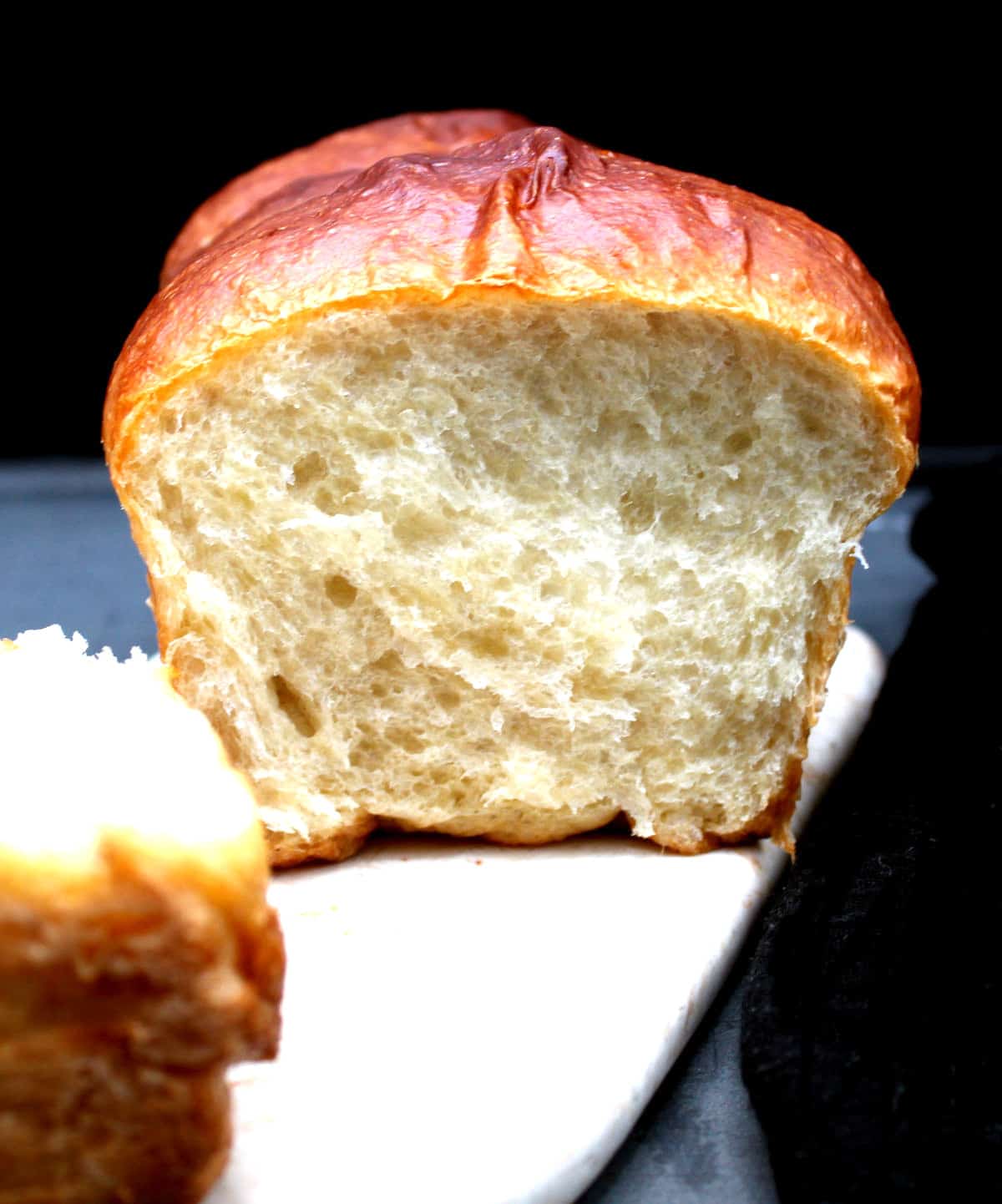
Ingredients
- Active dry yeast or instant yeast. You can use either, with no difference to the results. I more often than not use active dry yeast.
- Non-dairy milk. Use any milk of your choice, including almond milk, soy milk, oat milk and cashew milk.
- Sugar. A brioche needs to be lightly, but not very, sweet. Use any granulated sugar here. I used turbinado sugar.
- Bread flour and all-purpose flour. You need a combination to acquire the right texture. However, if all-purpose flour is all you have, you can substitute that for the bread flour.
- Extra virgin olive oil. You won't really taste the olive oil in the bread, but it will add a wonderful richness and flavor.
For optional "egg" wash
- Maple syrup. A simple "egg" wash of equal parts maple syrup, olive oil and aquafaba help make this loaf even more golden and stunning.
Watch how to make vegan brioche
Helpful tips
- Two rises for amazing flavor: Brioche is a labor of love because making the dough takes a little longer than making an average bread dough does, and you need to go through two rises, like a true French baker would. Remember, if something is worth doing, it's worth doing right. Patience is key here.
- Take your time to beat the fat into the dough: One of the things that gives brioche its unique texture is that you beat in the fat after the dough has already been formed and kneaded. Butter incorporates faster into the dough, because it is semi-solid at room temperature, but olive oil will take a bit longer: about 10-15 minutes in all, or 3-5 minutes after each addition of olive oil.
- Shape the brioche: You can shape the brioche in a sectioned loaf, which I usually do, or, if you have a brioche pan, you can use that instead. If you have smaller brioche molds, use them to make 12 cute little brioche rolls with this recipe, but cut baking time down to about 12-15 minutes. You can also make smaller balls and nestle them in the loaf pan, which would make a rater cute loaf, or braid the dough, like a vegan challah. You can also simply bake the brioche into a regular loaf.
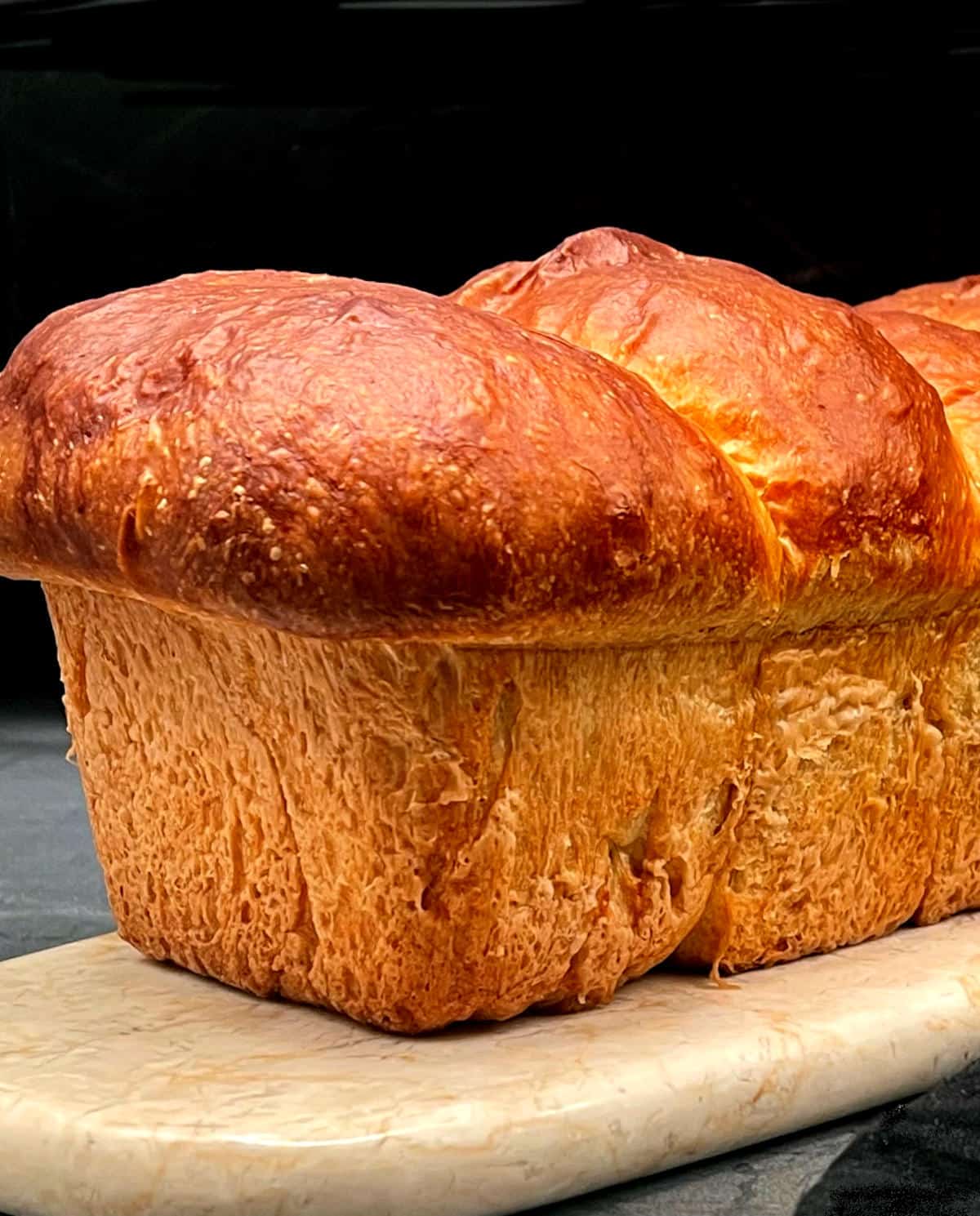
Recipe FAQs
You absolutely can. Substitute with an equal quantity of vegan butter: 12 tablespoons or 1 ½ sticks. Make sure the butter is at room temperature when you begin adding it to the dough.
I have a delicious vegan brioche buns recipe on the blog. But if you prefer using this dough instead, yes, go ahead and shape the dough into 10 balls and bake in a 2-quart baking dish and bake in a preheated 375-degree Fahrenheit/190-degree Celsius oven for 20 to 22 minutes.
You can skip the overnight rise and just proceed to shape into a loaf. However, you will sacrifice the amazing flavor that a slow, overnight rise gives the bread.
Uses for leftover brioche
Leftover brioche is one of the best foods to have on hand. It toasts beautifully and is divine with a pat of vegan butter and jam. But you can also repurpose it in so many creative ways.
- Vegan French Toast. Brioche is the perfect base for a delectable vegan French toast recipe. Or add the leftover brioche to this gorgeous vegan French toast casserole.
- Bread pudding. Add the brioche to a bread pudding, like this vegan apple bread pudding or this vegan pumpkin bread pudding.
- Savory dinner casserole. The slightly sweet brioche works wonders in savory casserole recipes. Try adding it to this vegan muffaletta casserole instead of Italian bread, or this vegan spinach, sausage and cheese casserole.
- Strata. Brioche is especially yummy in strata recipes, like this vegan zucchini breakfast strata.
- Sandwiches. Vegan brioche bread is great for sandwiches. Use it for a simple PBJ or add lots of savory fillings of your choice.
Storage instructions
- Refrigerate: Store the vegan brioche in a bread box or airtight container or plastic bag at room temperature or in the fridge for up to five days.
- Freeze: Freeze the brioche in a freezer-safe container or bag for up to four months.
- Thaw fully and warm in oven before serving.
More yummy vegan bread recipes
If you make this recipe, be sure to leave a comment and a star rating below. Or tag us on Instagram #HolyCowVegan.
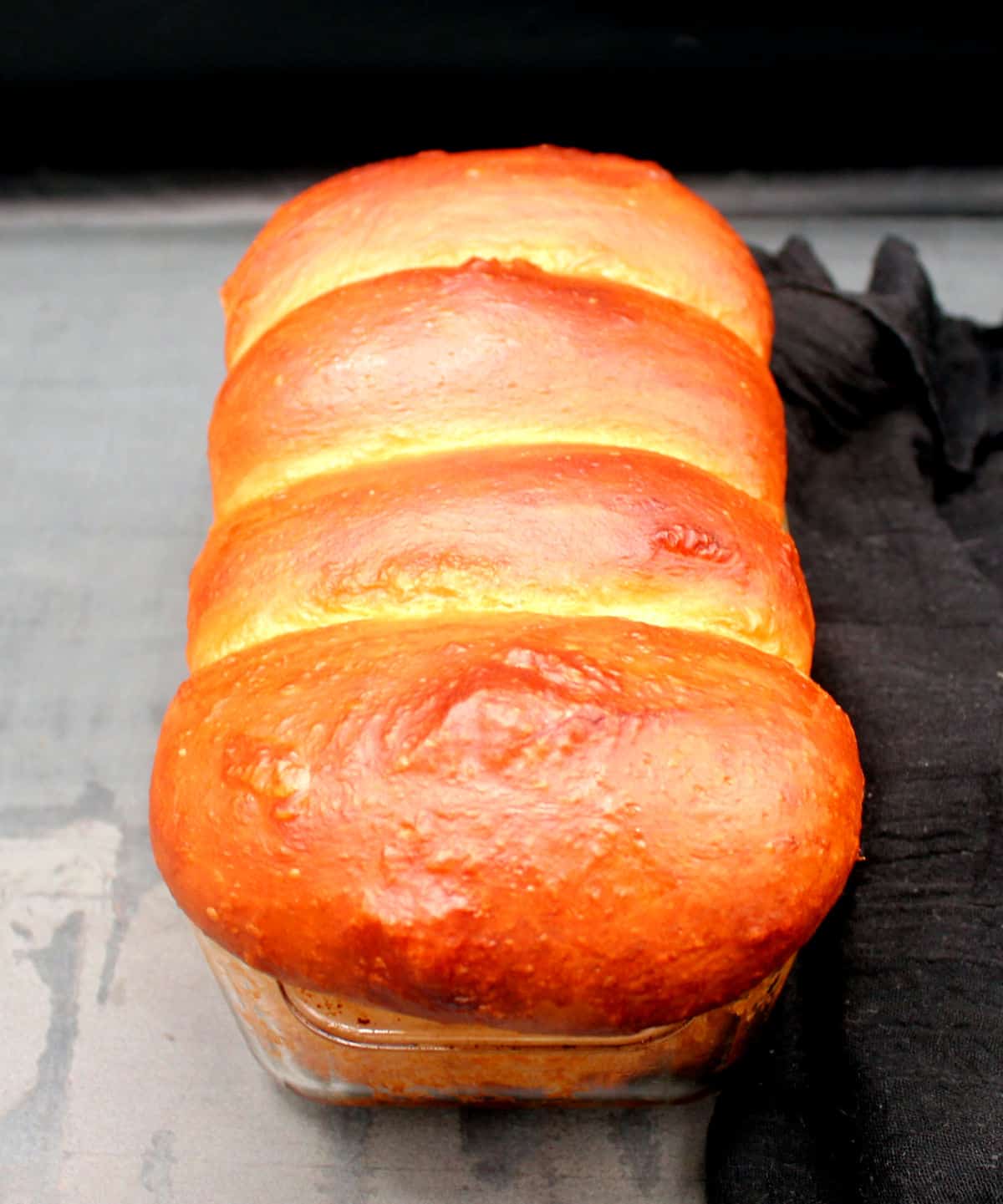
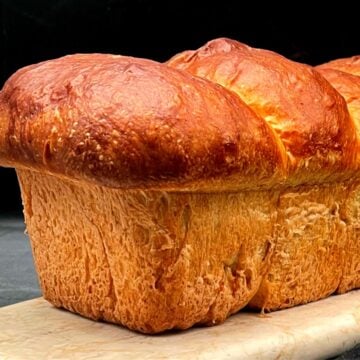
Vegan Olive Oil Brioche Recipe
Equipment
- Loaf pan or brioche pan
Ingredients
- 2 ¼ tsp (1 package) active dry yeast
- ⅓ cup + 2 tbsp nondairy milk
- 1 cup unbleached all-purpose flour
- 1 ¾ cup bread flour
- ¾ cup aquafaba
- ¼ teaspoon salt
- 3 tablespoon sugar
- ¾ cup extra virgin olive oil (use a good quality olive oil for best results)
Optional "egg" wash
- 1 teaspoon extra virgin olive oil
- 1 teaspoon maple syrup
- 1 teaspoon aquafaba
Instructions
Make the brioche dough
- Place the yeast and ⅓rd cup of warm, nondairy milk in the bowl of a stand mixer and let the yeast bloom, about five minutes.
- Add the all-purpose flour, aquafaba, sugar, and salt to the yeast mixture. Mix well on medium speed until everything is incorporated.
- Add the bread flour and knead for five minutes on medium speed or until the dough comes off the sides of the bowl and clumps around the dough hook.
- Add a third of the olive oil and knead it into the dough. It will look like there is too much oil in the beginning, but don't worry. Be patient and the dough will eventually begin to absorb the oil. It takes between 3-5 minutes on medium speed for the oil to absorb into the dough. Once the oil has absorbed, add another third of the olive oil and knead it into the dough. Repeat with the final third of the olive oil.
- When all of the oil is gone and the dough looks smooth again but sticks slightly to the bottom, you are done kneading. Scrape the dough out of the bowl and onto a lightly floured board. Form into a smooth ball.
- Place the dough into a large, oiled bowl (or back in the bowl of the mixer after oiling) and cover with cling wrap. Place in a warm place to rise for 90 minutes.
- After 90 minutes, the dough should have doubled. Punch it down and once again form the dough into a smooth ball. Place it back in the bowl, cover, and refrigerate overnight or for 8-12 hours.
Shape the brioche
- In the morning the dough should have risen again. If it's not doubled at least, let it stand outside in a warm place until it doubles. Otherwise, punch the dough down and shape into four even balls.
- Let the balls stand on the countertop, covered with a kitchen towel, for 10 minutes. Meanwhile, oil a standard eight-inch loaf pan. Place the four balls side by side in the pan so they are touching each other.
- For a shiny top, mix the optional "egg" wash or glaze ingredients in a small bowl and apply to the top of the brioche with a brush. Do this once more just before putting the loaf in the oven.
Bake the brioche
- Once the loaf has risen and domed over the pan (about 90 minutes), place in a preheated 375 degree oven and bake for 30 minutes.
- Remove the loaf pan and let it cool on a rack until it can be handled, about 30 minutes. Remove the loaf from the pan and let it cool thoroughly on a rack. Serve.
Video
Notes
- To make this brioche with vegan butter instead of olive oil, substitute the olive oil with 12 tablespoons of 1 ½ sticks of vegan butter at room temperature.
- Refrigerate: Store the vegan brioche in a bread box or airtight container or plastic bag at room temperature or in the fridge for up to five days.
- Freeze: Freeze the brioche in a freezer-safe container or bag for up to four months.
- Thaw fully and warm in oven before serving.



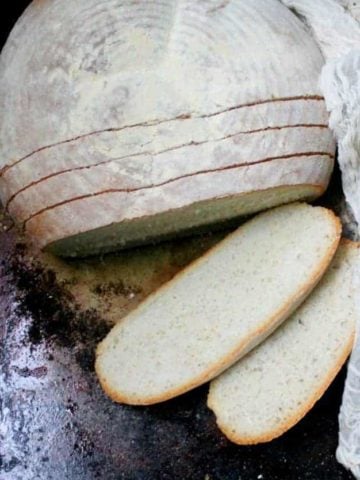
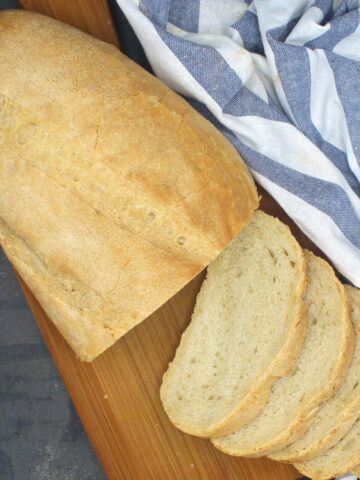
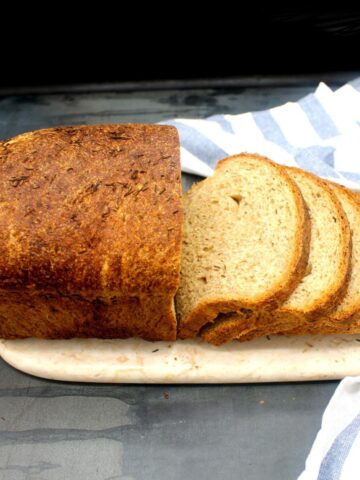
Dee M
I would like to know if this recipe can be made with eggs? I am not vegan and I don’t like the thought of using Aquafaba. If the result is not compromised how many eggs would you substitute for the aquafaba ingredient. Thank you.
Vaishali
It's a quarter cup of aquafaba per egg. You can just skip both the eggs and the aquafaba.
Alexa
My most favorite bread ever! I make this recipe at least once a week. My family loves it, especially my kids, and the olive oil makes it a healthier indulgence. Thanks sooo much!!